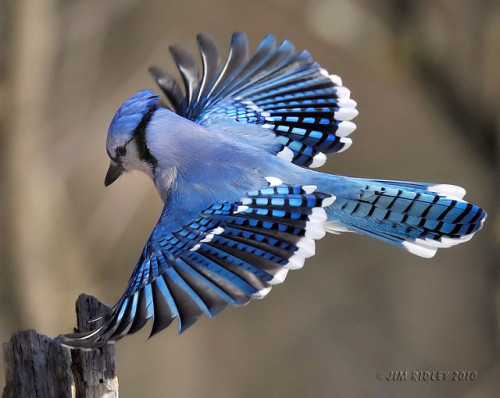(Powerline right-of-way)
This finding resulted from a three-year study of 93 ROW plots in southeastern Connecticut. Selective removal of trees from the plots keeps the power lines and their maintenance crews safe from potentially dangerous branches, while also preserving a perpetual early-successional shrubland habitat. Since many shrub-loving bird species have been declining in North America over the past several decades--often as a result of habitat loss--the designers of the current study hypothesized that ROWs might provide some much-needed breeding and feeding grounds.
Indeed, point counts detected a total of 65 different species, including two, the yellow-breasted chat (Icteria virens) and brown thrasher (Toxostoma rufum), that are species of conservation concern in Connecticut. Among of the five most common species (eastern towhee, Pipilo erythrophthalmus; gray catbird (Dumetella carolinensis; brown-headed cowbird, Molothrus ater; prairie warbler, Dendroica discolor; and field sparrow, Spizella pusilla), three are associated predominantly with shrublands and are therefore in particular need of habitat supplementation.
(Yellow-breasted chat, Icteria virens: a Connecticut-listed endangered species)
Superficially, this seemed like good news. However, the researchers wanted to dig a bit deeper and investigate whether ROWs offer a safe and productive environment in which to breed, or whether they might instead act as population sinks--habitats that are sustained only through the continued immigration of outsiders. To do this, the scientists located and monitored nests of the three most common shrubland-obligate species: eastern towhees, prairie warblers, and field sparrows. The results put a very different spin on their previous findings. Individual field sparrow nests had, at 20.6%, the highest observed chance of fledging young; this value dropped to 19% for prairie warbler nests and 15.5% for eastern towhee nests in the best years, and even lower at other times. The silver lining in the cloud was that, thanks to successful re-nesting attempts, individual females had up to a 71% chance of fledging at least one chick during the breeding season. All the same, reproductive rates of both species were too low to "balance losses from mortality," indicating that the ROW populations could only persist if fed by migrants from elsewhere.
Although the main reason for nest failure was predation, probably by animals such as eastern chipmunks (Tamias striatus), blue jays (Cyanocitta cristata), and American crows (Corvus brachyrhynchos), another important factor was brood parasitism by brown-headed cowbirds. This was particularly common in nests located nearer to roads and buildings--an association that emphasized the importance of broader habitat and landscape variables. These were examined in more detail via vegetation surveys and computer-based landcover analyses. Some relationships were species-specific, but the researchers also found some enlightening general trends. For example, shrubland bird diversity and abundances were generally lower in areas that had higher levels of developed and agricultural habitat in the surrounding landscape. Additionally, many species were less common in narrower ROWs.
(Blue jay, Cyanocitta cristata, a potential predator of shrubland-nesting species--or, more specifically, their eggs and young)
A range of fledging rates have been reported for ROWs studied in the past; these range from values comparable to those reported here to near complete nesting success. In other words, although ROWs can provide good habitat for declining shrubland bird species, they are not guaranteed to do so. It appears that an important determinant of success is the type of land cover in neighboring habitats. Specifically, ROWs in the midst of more anthropogenically altered habitat are lower quality than those in more forested areas. This is because potential predators and brood parasites will be found at lower densities in ROWs when they have alternative habitats to choose from, but will descend on shrubland areas if these are the only available places to occupy.
On the whole, the researchers feel that their results show the potential usefulness of selective tree removal as a shrubland-creating management technique that can
promote biodiversity. Although this method is commonly used in Australia and North America, it has yet to gain much traction in Europe and East Asia, where shrubland birds are also on the decline; corridors in the middle of protected forests would make particularly good targets. However, the authors recommend that managers keep a close eye on ROW habitats in order to assess whether they are a source or sink for local birds. Sinks are not necessarily a bad thing--for instance, where neighboring shrubland habitats are producing an overabundance of individuals whose settlement in ROWs can perpetuate the local population--but could become detrimental if there are no nearby sources of immigrants. Perhaps most importantly, the researchers advise against the creation of any new corridors that would fragment, or further fragment, surrounding forested areas.
---
For supplemental images associated with this post, visit the Anthrophysis pin board at Pinterest.
Askins, R.A., Folsom-O'Keefe, C.M., and Hardy, M.C. 2012. Effects of vegetation, corridor width and regional land use on early successional birds on powerline corridors. PLoS ONE 7(2):e31520.
Thanks to the following websites for providing the images used in this post:
http://www.nj.com/news/index.ssf/2009/06/pseg_offers_1k_to_property_own.html
http://fishandgame.idaho.gov/ifwis/ibt/site.aspx?id=50
http://www.flickr.com/photos/jrnikon


No comments:
Post a Comment